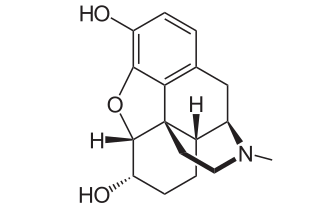Anticonvulsants are a diverse group of pharmacological agents used in the treatment of epileptic seizures. Anticonvulsants are also increasingly being used in the treatment of bipolar disorder and borderline personality disorder, since many seem to act as mood stabilizers, and for the treatment of neuropathic pain. Anticonvulsants suppress the excessive rapid firing of neurons during seizures. Anticonvulsants also prevent the spread of the seizure within the brain.

Levetiracetam, sold under the brand name Keppra among others, is a novel antiepileptic drug (medication) used to treat epilepsy. It is used for partial-onset, myoclonic, or tonic–clonic seizures, and is taken either by mouth as an immediate or extended release formulation or by injection into a vein.

Phenobarbital, also known as phenobarbitone or phenobarb, sold under the brand name Luminal among others, is a medication of the barbiturate type. It is recommended by the World Health Organization (WHO) for the treatment of certain types of epilepsy in developing countries. In the developed world, it is commonly used to treat seizures in young children, while other medications are generally used in older children and adults. It is also used for veterinary purposes.

Status epilepticus (SE), or status seizure, is a medical condition consisting of a single seizure lasting more than 5 minutes, or 2 or more seizures within a 5-minute period without the person returning to normal between them. Previous definitions used a 30-minute time limit. The seizures can be of the tonic–clonic type, with a regular pattern of contraction and extension of the arms and legs, or of types that do not involve contractions, such as absence seizures or complex partial seizures. Status epilepticus is a life-threatening medical emergency, particularly if treatment is delayed.

Primidone, sold under various brand names, is a barbiturate medication that is used to treat partial and generalized seizures and essential tremors. It is taken by mouth.

Vigabatrin, sold under the brand name Sabril among others, is a medication used in the management and treatment of infantile spasms and refractory complex partial seizures.

Clobazam, sold under the brand names Frisium, Onfi and others, is a benzodiazepine class medication that was patented in 1968. Clobazam was first synthesized in 1966 and first published in 1969. Clobazam was originally marketed as an anxioselective anxiolytic since 1970, and an anticonvulsant since 1984. The primary drug-development goal was to provide greater anxiolytic, anti-obsessive efficacy with fewer benzodiazepine-related side effects.

Clorazepate, sold under the brand name Tranxene among others, is a benzodiazepine medication. It possesses anxiolytic, anticonvulsant, sedative, hypnotic, and skeletal muscle relaxant properties. Clorazepate is an unusually long-lasting benzodiazepine and serves as a prodrug for the equally long-lasting desmethyldiazepam, which is rapidly produced as an active metabolite. Desmethyldiazepam is responsible for most of the therapeutic effects of clorazepate.

Dihydromorphine is a semi-synthetic opioid structurally related to and derived from morphine. The 7,8-double bond in morphine is reduced to a single bond to get dihydromorphine. Dihydromorphine is a moderately strong analgesic and is used clinically in the treatment of pain and also is an active metabolite of the analgesic opioid drug dihydrocodeine. Dihydromorphine occurs in trace quantities in assays of opium on occasion, as does dihydrocodeine, dihydrothebaine, tetrahydrothebaine, etc. The process for manufacturing dihydromorphine from morphine for pharmaceutical use was developed in Germany in the late 19th century, with the synthesis being published in 1900 and the drug introduced clinically as Paramorfan shortly thereafter. A high-yield synthesis from tetrahydrothebaine was later developed.

Beclamide is a drug that possesses anticonvulsant activity. It is no longer used.
Ethotoin is an anticonvulsant drug used in the treatment of epilepsy. It is a hydantoin, similar to phenytoin. It is not available in the United States.
Methylphenobarbital (INN), also known as mephobarbital and mephobarbitone (BAN), marketed under brand names such as Mebaral, Mephyltaletten, Phemiton, and Prominal, is a drug which is a barbiturate derivative and is used primarily as an anticonvulsant, but also as a sedative and anxiolytic. It is the N-methylated analogue of phenobarbital and has similar indications, therapeutic value, and tolerability.

Metharbital was patented in 1905 by Emil Fischer working for Merck. It was marketed as Gemonil by Abbott Laboratories. It is a barbiturate anticonvulsant, used in the treatment of epilepsy. It has similar properties to phenobarbital.

Mephenytoin is a hydantoin, used as an anticonvulsant. It was introduced approximately 10 years after phenytoin, in the late 1940s. The significant metabolite of mephenytoin is nirvanol (5-ethyl-5-phenylhydantoin), which was the first hydantoin. However, nirvanol is quite toxic and mephenytoin was only considered after other less toxic anticonvulsants had failed. It can cause potentially fatal blood dyscrasia in 1% of patients.

Cyclobarbital, also known as cyclobarbitol or cyclobarbitone, is a barbiturate derivative. It was available in Russia as a fixed-dose combination with diazepam for the treatment of insomnia but was discontinued in 2019.

Allobarbital, also known as allobarbitone and branded as Dial, Cibalgine, or Dial-Ciba, is a barbiturate derivative invented in 1912 by Ernst Preiswerk and Ernst Grether working for CIBA. It was used primarily as an anticonvulsant although it has now largely been replaced by newer drugs with improved safety profiles. Other uses for allobarbital included as an adjutant to boost the activity of analgesic drugs, and use in the treatment of insomnia and anxiety.

Aprobarbital, sold under the brand names Oramon, Somnifaine, and Allonal, is a barbiturate derivative invented in the 1920s by Ernst Preiswerk. It has sedative, hypnotic, and anticonvulsant properties, and was used primarily for the treatment of insomnia. Aprobarbital was never as widely used as more common barbiturate derivatives such as phenobarbital and is now rarely prescribed. It has been largely replaced by newer drugs with a better safety margin.

Lacosamide, sold under the brand name Vimpat among others, is a medication used for the treatment of partial-onset seizures and primary generalized tonic-clonic seizures. It is used by mouth or intravenously.
Post-traumatic epilepsy (PTE) is a form of acquired epilepsy that results from brain damage caused by physical trauma to the brain. A person with PTE experiences repeated post-traumatic seizures more than a week after the initial injury. PTE is estimated to constitute 5% of all cases of epilepsy and over 20% of cases of acquired epilepsy.

Hydroxyphenamate or oxyfenamate is a sedative and anxiolytic drug of the carbamate class which is no longer marketed in the US. Like other carbamate sedatives, it is chemically related to meprobamate (Miltown). It was introduced to the US market in 1961. The dosage for adults is 200 mg 3 to 4 times daily.
















